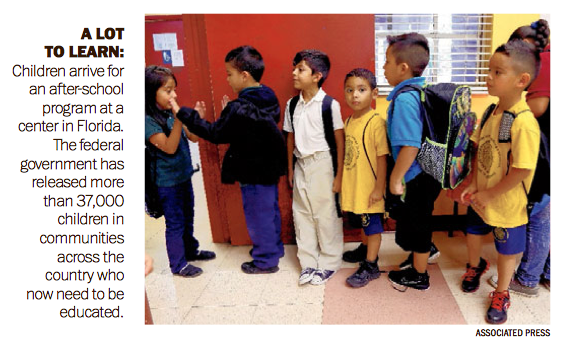As it happens, Washington’s obstinate auto-pilot immigration has imported millions of poor people who will never live without taxpayer-funded assistance for food, housing and education. The policy leaves our own poor people with the short end of the stick as schools in low-income areas are ever more crowded and dysfunctional, and American workers must compete with foreigners for jobs.
Below, a group of Obama’s border surge kids line up to get some free-to-them stuff supported by American taxes.

As economist George Borjas remarked the other day, mass immigration is the world’s “largest anti-poverty program” — although the influx is not kind to America’s poor and working class. “The largest loss is probably the wage drop suffered by the workers who now face more competition in the labor market,” Borjas said.
Op-Ed: Why does the U.S. have such an outlier child poverty rate? Our immigration system has a lot to do with it, By Kay S. Hymowitz, Los Angeles Times, October 29, 2017Articles about America’s high levels of child poverty are a media evergreen. Here’s a typical entry, courtesy of the New York Times’s Eduardo Porter: “The percentage of children who are poor is more than three times as high in the United States as it is in Norway or the Netherlands. America has a larger proportion of poor children than Russia.” That’s right: Russia.
Outrageous as they seem, the assertions are true — at least in the sense that they line up with official statistics. Comparisons of the sort that Porter makes, though, should be accompanied by an asterisk pointing to a very American reality. Before Europe’s recent migration crisis, the United States was the only developed country to routinely import millions of very poor, low-skilled families, from some of the most destitute places on Earth — especially from undeveloped areas of Latin America — into its communities, schools and hospitals. Let’s just say that Russia doesn’t care to do this — and, until recently, Norway and the Netherlands didn’t, either.
Pundits prefer silence on the relationship between America’s immigration system and poverty, and it’s easy to see why. The subject pushes us into the sort of wrenching trade-offs that politicians and advocates prefer to avoid. Here’s the problem in a nutshell: You can allow mass low-skilled immigration, which many consider humane. But if you do, it becomes a lot harder to pursue the equally humane goal of reducing child poverty in this country.
::
In 1964, the federal government settled on a standard definition of poverty: an annual income less than three times the amount required to feed a family (size dependent) over that period of time. Back then, close to 23% of American kids were poor. Today, about 18% of kids are below the poverty line, amounting to 13,250,000 children.
At first, immigration did not affect child-poverty figures. The 1924 Immigration Act sharply reduced the number of immigrants from poorer Eastern European and southern countries, and it altogether banned Asians. The relatively small number of immigrants settling in the United States tended to be from affluent nations. According to the Migration Policy Institute, in 1970, immigrant children were less likely to be poor than were the children of native-born Americans.
By 1980, the situation had reversed: immigrant kids were now poorer than native-born ones. Why? The 1965 Immigration and Naturalization Act overturned the 1924 restrictions and made “family preference” a cornerstone of immigration policy. In consequence of that move, as well as large-scale illegal immigration, a growing number of new Americans hailed from less-developed countries. As of 1990, immigrant kids had poverty rates 50% higher than their native counterparts. At the turn of the millennium, more than one-fifth of immigrant children were classified as poor.
Perhaps the most uncomfortable truth about these statistics is that a large majority of America’s poor immigrant children — and, at this point, a large fraction of all its poor children — are Latino.
(Continues)